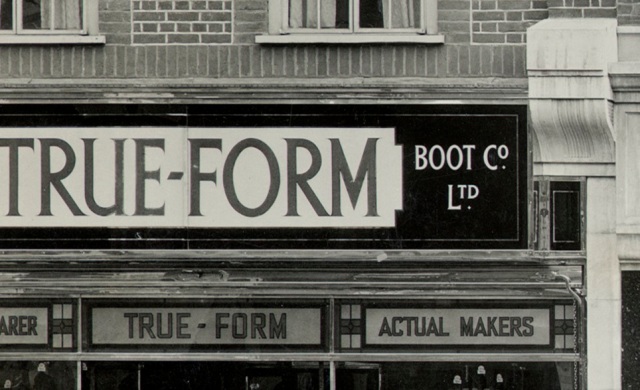
True-Form, Canning Town, London, 1930s. c. Historic England
The boot and shoe manufacturer J. Sears & Co. (True-Form Boot Co.) Ltd. was founded in Northampton in 1891 by John George Sears (1870-1916), who was soon joined in business by his younger brother William Thomas Sears (1876-1950). The Sears brothers were following in their father’s trade: John started out as a ‘clicker’ – cutting leather for uppers – then became a foreman. Their first factory was on Derby Road and the second on Gray Street, but in 1904 they moved to larger premises, equipped with the latest machinery, on the corner of Stimpson Avenue and Adnitt Road. In 1908 a warehouse was built next to the factory, to store goods prior to their distribution to retail branches. A stock room and packing department were added in 1910.

Sears Factory, Adnitt Road, Northampton, 1913. c. Historic England

Sears Factory, Stimpson Avenue, Northampton, 1924-25. c. Historic England
The first True-Form shop opened in 1897, providing the Sears brothers with a way of distributing goods without resorting to factors or travelling salesmen. This was followed quickly by additional outlets. As with other multiple enterprises, goods were sold for cash rather than credit.

True-Form, Canning Town, London. c. Historic England
By 1912 – when its best-known boots sold for 10s. 3d. – the company operated 47 shops in London and 33 elsewhere. Most provincial branches were in English cities, but there were two outlets in Glasgow, and one each in Edinburgh, Swansea and Cardiff. Sears prided themselves on their window displays: ‘The boots and shoes are displayed in a novel manner, and their price in plain figures is not only stamped on the sole before leaving the factory, but is openly displayed to the possible customer who gazes through the shop window’ (The Times, 21 February 1912, 17).
In 1912 Sears became a limited liability company. The Great War brought about the usual problems: employees joined the forces and materials were hard to source. The demand for Army boots was so great that the company struggled to supply its civilian customers. Business boomed, however, after 1918. A multi-storey factory extension for men’s footwear was built in 1924-25 to a design by the architect F. H. Allen, and a ‘factory for repairing boots and shoes’ was built in London in 1928. Later that same year, after several months of negotiation, Sears bought out its rival Freeman, Hardy & Willis, which continued as a separate operation. Together they owned 722 shops, 300 of which were freeholds. Shortly afterwards, the True-Form factory for women’s footwear was extended, as was the warehouse. The Depression, however, delivered difficult trading conditions in the early 1930s, and Sears’ profits fell for the first time since the war. Trade stabilised in the mid-1930s, and older retail branches were refurbished.

True-Form, Canning Town, London. c. Historic England
In the 1930s, the lobbies of True-Form shops were closed by gates incorporating sunbursts. Different glazing patterns were used but some transom lights, for example in Doncaster, incorporated foot-print-shaped panels bearing the name ‘TrueForm’ – a motif also used on products such as packets of shoe polish and shoe trees. A ‘ghost sign’ of similar vintage can still be seen on the side of a hair salon (‘Rush’) on Wimbledon Broadway, otherwise little trace survives of this particular chain.

Coventry, c.1930. c. Historic England
In 1953, three years after the death of the co-founder and Chairman W. T. Sears, the company was acquired by the entrepreneur Charles Clore (1904-1979). Almost immediately, Clore sold off many of Sears’ properties – including True-Form and Freeman, Hardy & Willis shops – with lease-back agreements. He had raised £4.5 million from property sales by the end of 1953, and proposed selling additional properties to the value of £1 million.
The next step was for J. Sears & Co. to hand its True-Form footwear business over to Freeman, Hardy & Willis. Sears, renamed Sears Holdings in 1955, became no more than a holding company. After Dolcis and Manfield were acquired in 1956, Sears’ footwear group was named the British Shoe Corporation. This expanded with the acquisition of Saxone and Lilley & Skinner in 1962. Sears Holdings began to invest in department stores and other retailers in the 1960s (notably Lewis’s department stores [including Selfridges], William Hill, Wallis, Adams, Richard Shops). True-Form underwent several changes of image throughout the following decades, for example a revamp by Cardona Platt Associates in 1988.
The various footwear brands grouped under British Shoe Corporation – including True-Form – were sold off to Fascia, which went into receivership in 1996. A shrunken Sears plc was acquired by Philip Green in 1999.
Click here to read about the boot and shoe factories of Northamptonshire

Very interesting. I am related to John George Sears (Greats Uncle) so was nice to be able to find this information on line. Thanks.
LikeLike
Pingback: Crockett & Jones | kleiderschrank
I have a shoe horn in alloy showing crest J Sears & Co, True-Form & Boot Co Ltd. Must be quite old i woul think.
LikeLike
Did they have a satellite factory in Kettering, by any chance?
LikeLike
I worked for True-Form in the 60’s and it was brilliant to see Islington were I worked so thank you .
LikeLike
My late grandfather, John MacDonald, ran the Putney High St branch of True-Form in the 1960s and early 1970s.
LikeLike
I worked for Tru form shoes in mid 1980,s in Plymouth, best job I ever had
LikeLike
Does anyone know the address of the Newcastle store. I have a photo circa 1920 but no address.
LikeLike